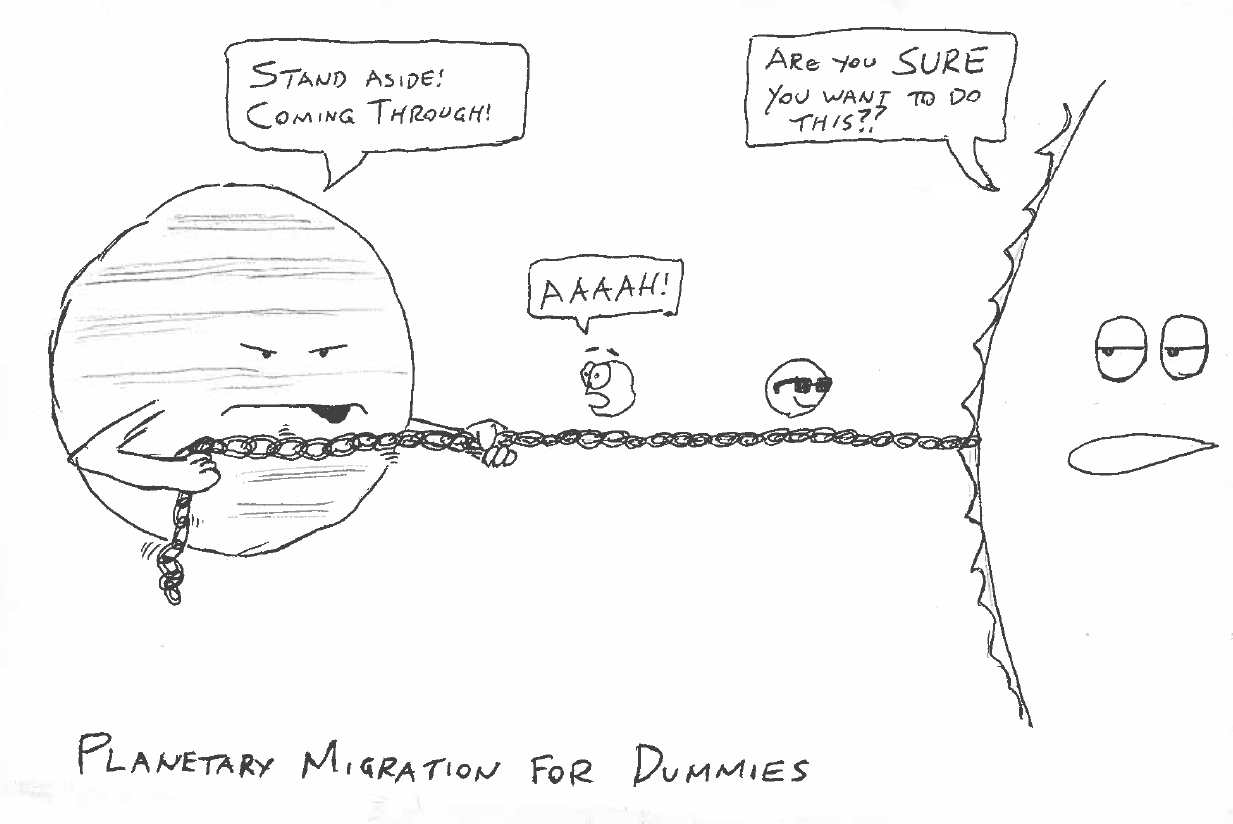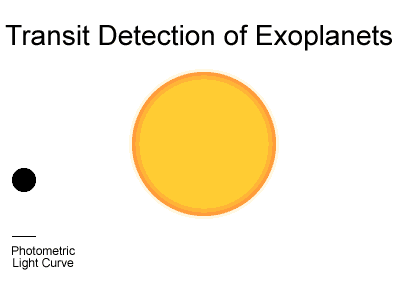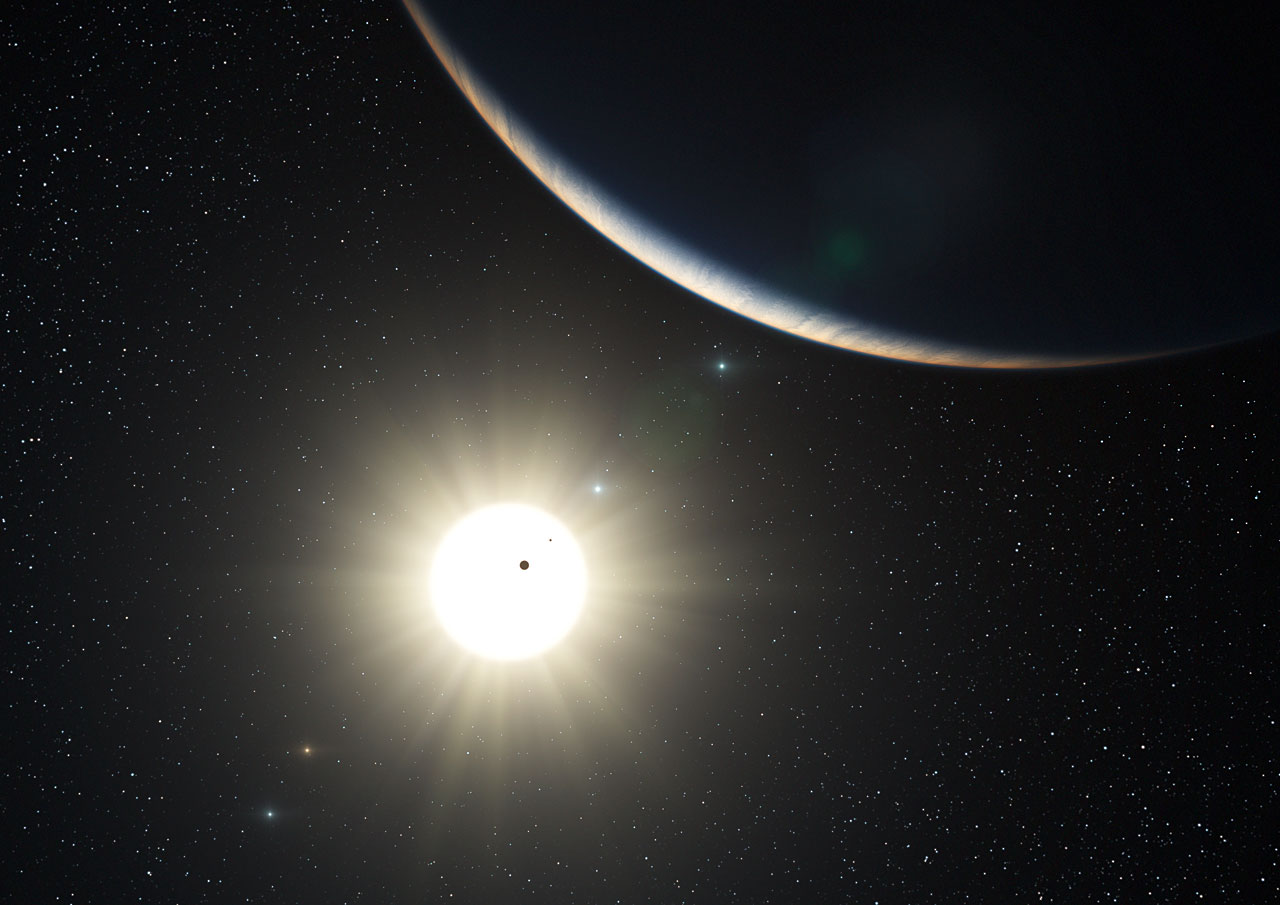Key points: How planets are
detected or inferred to be present around other stars; how common they are; how
the known planet systems compare with the Solar System
 |
We are finding evidence for massive planets around many stars from Doppler shifts indicating something unseen orbiting the star. This animation is based on a real system (from
Sylvain G. Korzennik, http://cfa-www.harvard.edu/afoe/orbits/If
you watch closely, you can see a small movement of the star around the common center of
mass of it and the massive planet orbiting it. The resulting Doppler shift of the stellar
lines is shown in the graph at the bottom. The net effect is just over + 50 m/s,
about + 0.00002%. It is just possible to detect such a tiny shift in the
wavelengths of the spectral lines. An earth-sized planet would produce
shifts more than a hundred times smaller, less than we can measure. Also, a
large planet too far from the star would produce too slow a recoil for us to
have detected it. These systems must be examples where a gas giant planet
formed far from the star and migrated inward as described above. |
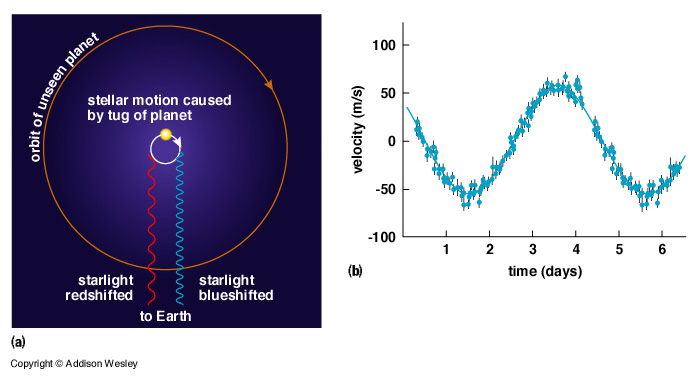 |
This diagram shows what is happening in more
detail. (From The
Essential Cosmic Perspective, by Bennett et al.) |
| Here is a sampling of the planets found (mostly) in this way. The
vertical column of yellow disks to the left represents the stars, while the
other disks with black shading are planets. Masses are compared with that of
Jupiter. There are 178 planets in 150 systems in this figure, but the TOTAL
number of planets we know about has topped 1000 (and is growing)! (from Exoplanet Encyclopedia, http://exoplanet.eu/) |
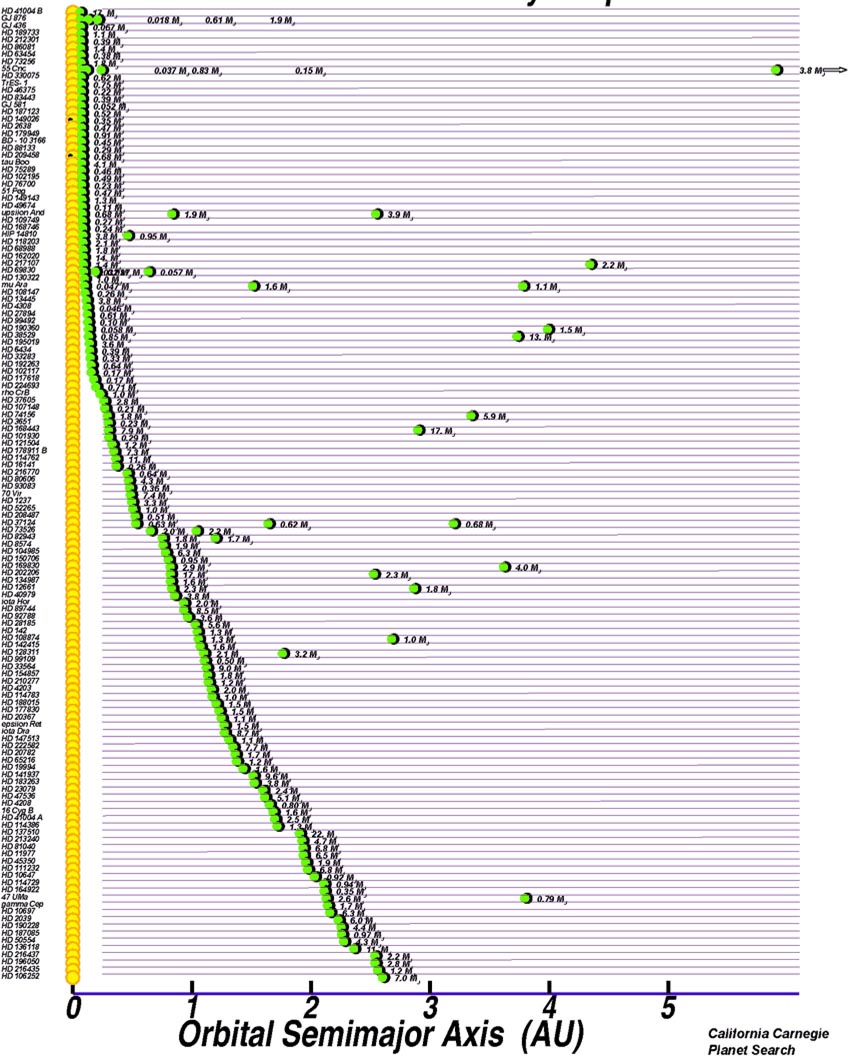 |
How did so many giant planets end up so close to their stars? All of these
planets are about as massive as Jupiter, yet most of them lie closer to their
stars than the earth lies to the sun.
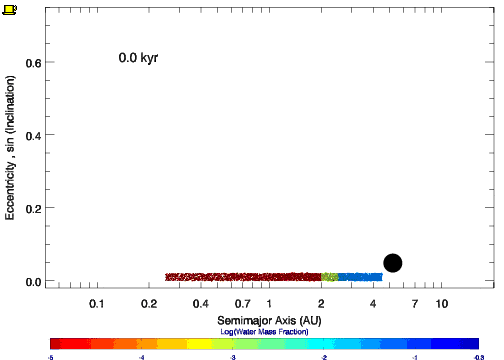 |
Around other stars, some of the planetesimals that did not
stick together to form planets still had a big influence on their systems.
The giant planets had to plow through swarms of them, and they slowed the
planets a bit like lots and lots of bugs hitting the windshield of your car
would slow it down. These planetesimals got thrown into eccentric orbits or
ejected from the systems, but the giant planets migrated inward, often to
orbits very close to the stars.
from http://casa.colorado.edu/~raymonsn/graphics.html Raymond, Mandell &
Sigurdsson (2006, Science, 313, 1413-1416), Sean Raymond |
Another approach to
finding planets is to look for
the small reduction in the light from a star when a planet passes between us and it -- a
transit. This requires that the planet orbit be lined up just so, but in spite of this alignment requirement, this technique has found the largest number of exoplanets -- largely from the Kepler mission which was designed to find exoplanets (seebelow). One is when Mercury or Venus pass between us and the sun:
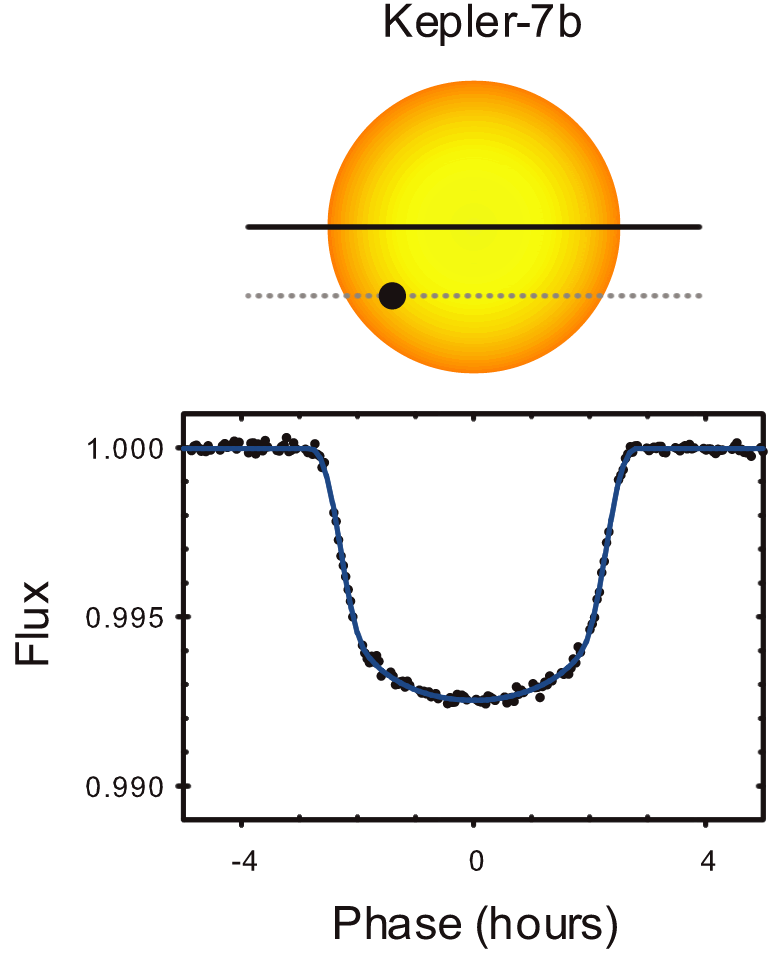 |
The Kepler satellite was built to look for
transiting planets (and some were found by the earlier CoROT mission also).
Here is an example - a planet that takes out nearly 1% of the light of the
star when it passes in front of it. This planet orbits its star in a little
less than 5 days, and has a mass about 40% as large as that of Jupiter. |
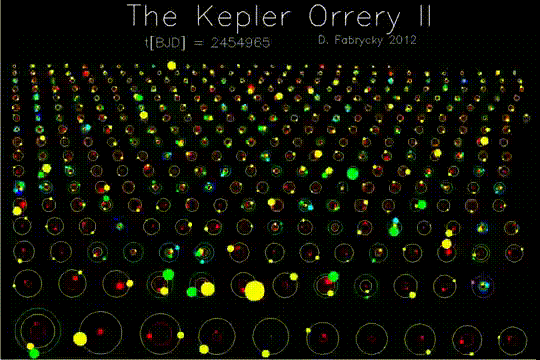 |
This animation shows the multiple-planet
system candidates found by the Kepler mission as of February 2012: 885
candidates in 361 systems. The orbit radii are to scale with respect to each
other, but the orbits and planet sizes are different scales. The colors are
in order of orbit size: two-planet systems (242 in all) have a yellow outer
planet; 3-planet systems (85) green; 4-planet (25) light blue; 5-planet (8)
dark blue; 6-planet (1, Kepler-11, purple). (from Kepler Mission
website, http://kepler.nasa.gov/multimedia/animations/?ImageID=219) |
| Planetary systems appear to form very frequently |
"There are countless suns and countless Earths all rotating around
their suns in exactly the same way as the seven planets of our system. We see only the
suns because they are the largest bodies and are luminous, but their planets remain
invisible to us because they are smaller and non-luminous.......The
countless worlds in the universe are no worse and no less inhabited than our
Earth"
- Giordano Bruno, 1548
- 1600, in De L'Infinito Universo E Mondi; picture from Wikipedia
Although we could give Bruno credit for being way ahead of his time
scientifically, he really had no evidence - and was outspoken about other
matters that ran contrary to religious doctrine. He spent the last seven
years of his life in prison (while at trial) and was then burned at the
stake. Nonetheless, we are now gathering scientific evidence that his
statements were correct! |
 |
More than a thousand planets are now known for sure and there are several thousand more that are likely (from Kepler). Almost all of these examples are giant planets that have migrated
inward to orbits very close to their stars. As many as 10% of stars like the
Sun have such planets, so the process must be common. Why didn't this happen in
the Solar System (with potentially disastrous consequences for Earth)? It is
proposed that we were saved by the accident of forming two massive planets close
to each other, and that the orbital resonance that caused the Late Heavy
Bombardment also stabilized Jupiter's and Saturn's orbits out where they are to
this day.
None of these systems let us look at how ones like ours
evolved; all of them are too different from ours, and we see them at some random
late time in their evolution. We need a different approach to learn about the
evolution of systems like ours. We are interested in systems where massive planet migration did not take place, that is systems that evolved more like the Solar System did.
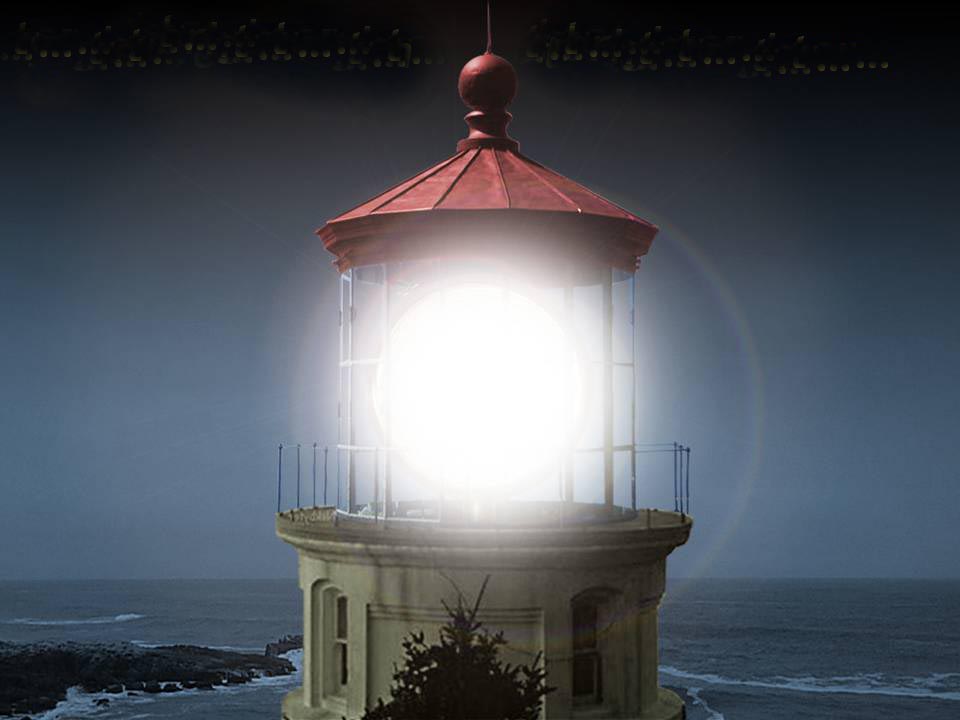 |
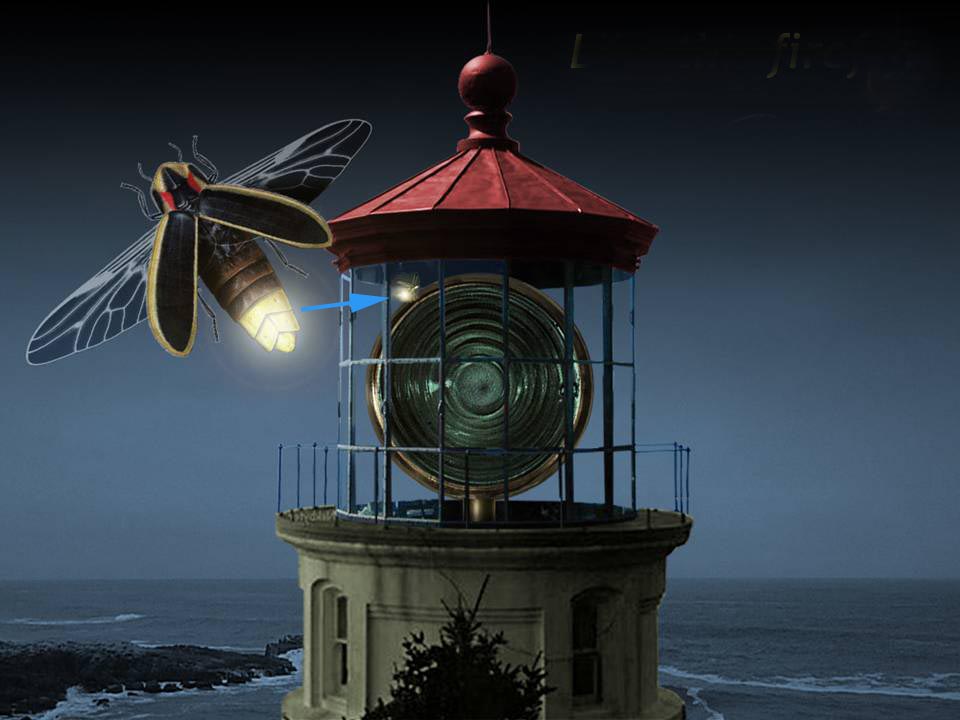 |
In fact,
we would like to take pictures of other planets. However, seeing normal planets
orbiting even the nearest stars is much more difficult than observing Doppler
recoils or transits, both because the planets
are so faint, and because they tend to be lost in the glare from the star itself. The stars are more than a billion times brighter. The
challenge is like trying to take a picture of a firefly circling the beam of
a lighthouse - except it is harder because the stars never turn off. (from Navigator Program Public
Engagement Team, NASA, http://planetquest.jpl.nasa.gov) |
We are developing instruments that can block the light of the star; however, they are not good enough to probe the planets that have migrated into tight orbits.Fortunately, there are also many examples
of stars surrounded by circumstellar disks of debris. The dust and small grains in these
disks will either be blown away from the star or will fall into it in only about a
million years. Therefore, the debris has to be renewed - we think this happens when small
planets, typically on the scale of large asteroids in the solar system - collide with each
other (from Robert Hurt, SSC) The debris disks therefore require systems where the small planets are on
large orbits, hinting that there might also be large planets far from the
stars in these systems. This has turned out to be correct! An example is in the Hubble Telescope (HST) images to the right. Fomalhaut is about 200 million years old. The
narrow ring is a system of debris from recent collisions that produced a
cloud of dust we now see spread in orbit around the star. The sharp inner
edge is maintained by a massive planet, whose orbital motion can be seen in
the inset to the lower right. (From NASA, ESA, P.
Kalas et al. http://apod.nasa.gov/apod/ap081114.html) (from Robert Hurt, SSC) The debris disks therefore require systems where the small planets are on
large orbits, hinting that there might also be large planets far from the
stars in these systems. This has turned out to be correct! An example is in the Hubble Telescope (HST) images to the right. Fomalhaut is about 200 million years old. The
narrow ring is a system of debris from recent collisions that produced a
cloud of dust we now see spread in orbit around the star. The sharp inner
edge is maintained by a massive planet, whose orbital motion can be seen in
the inset to the lower right. (From NASA, ESA, P.
Kalas et al. http://apod.nasa.gov/apod/ap081114.html) |
 |
| The debris disk was first discovered because
of the infrared emission from its heated dust. These images are rotated to
the true orientation on the sky (the HST one was fixed horizontal). They are at 70
microns (Herschel Telescope, from Acke et al.) showing
pretty much the same ring as seen by HST, but at lower resolution); and at
about 1 mm (ALMA, from Sky & Telescope)). At 70 microns, we see the side of the ring closer to the star
heated to a higher temperature; this offset of the ring can be seen in the
HST image above. The 1 mm image (just part of the ring) is in blue
superimposed on the HST one in visible light. At 1 mm we see the larger
particles (sand and gravel) that produce the dust seen heated at 70 microns
and scattering light in the visible (we also see the star at both
wavelengths). |
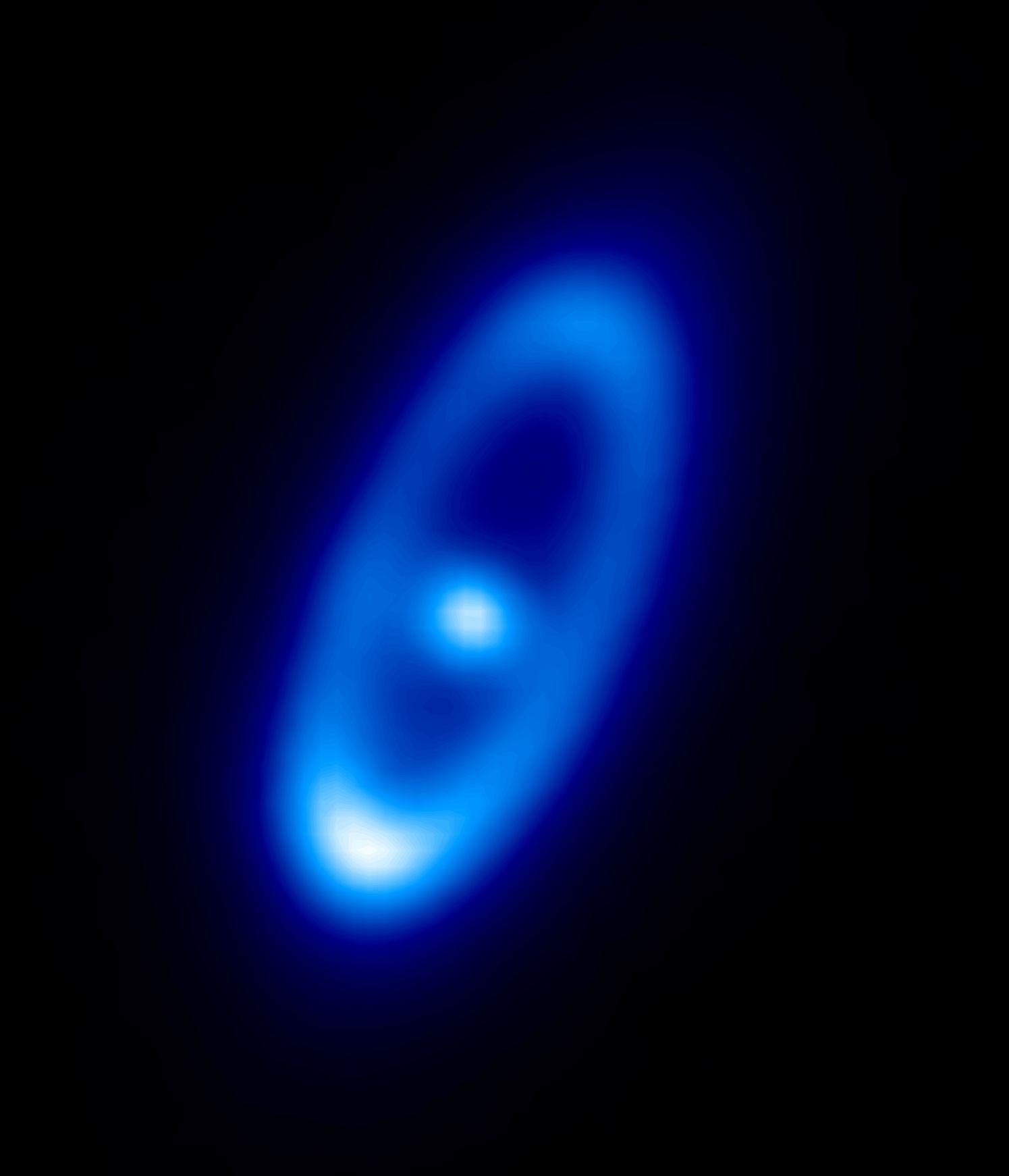 |
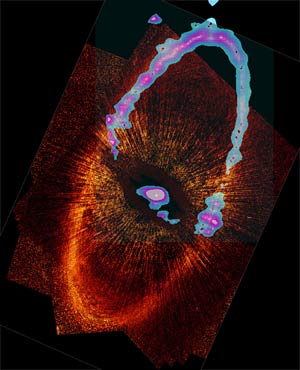 |
| A second example is HR 8799. Four massive
planets were discovered by Marois and others (see below), while Su, Rieke, and others
imaged the huge debris system (artist's concept to right). This star is much younger than Fomalhaut,
perhaps 30 million years old. It is not thought that the four planets can
stay in stable orbits and that one of them may be ejected from the system.
They are also stirring up the small bodies in the debris disk causing a lot
of collisions so the disk is very bright; small, weakly bound dust grains
are on very eccentric orbits extending to 1000 AU from the star, while tiny
grains are being ejected altogether through impacts with photons from the
star. (planet image from Marois et al., http://solarsystemwatch.blogspot.com/2010/12/hr-8799-hosts-jumbo-planetary-system.html,
disk concept by G. Rieke)
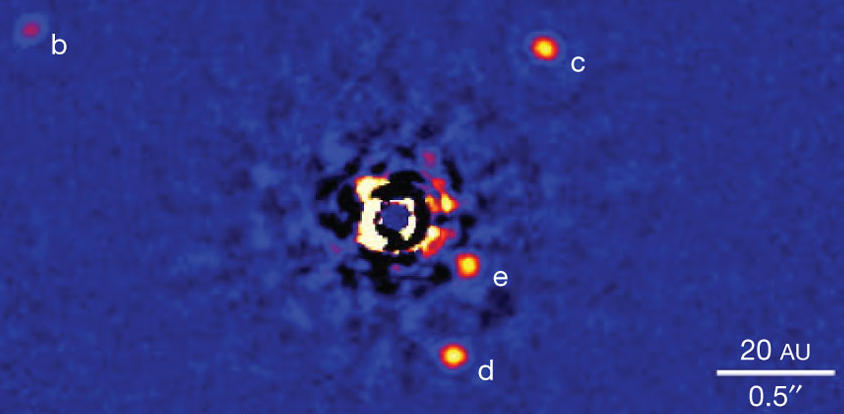 |
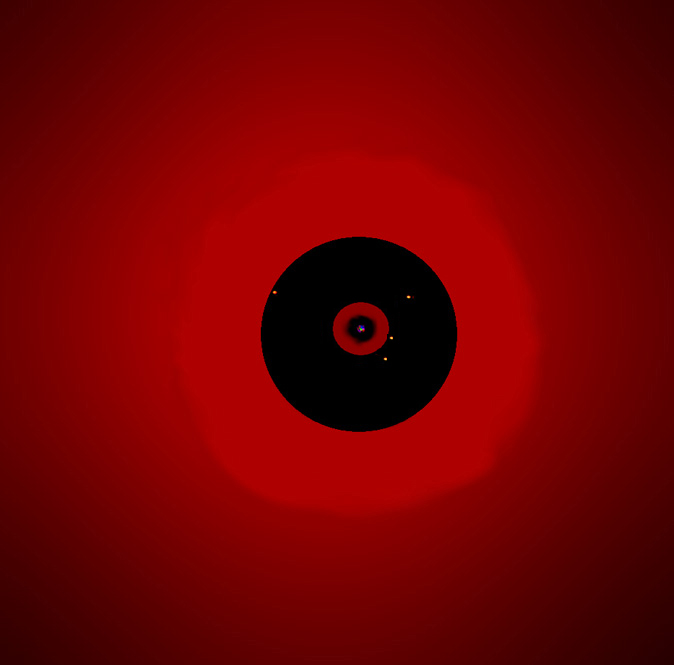 |
| An even more impressive disk
orbits the nearby very young star, beta Pictoris - however, because this star is only 10 - 20 million
years old, astronomers debate whether the disk is left over from its formation or is due
to a recent planet collision. Nonetheless, it too has a massive planet, as can
be seen to the right. |
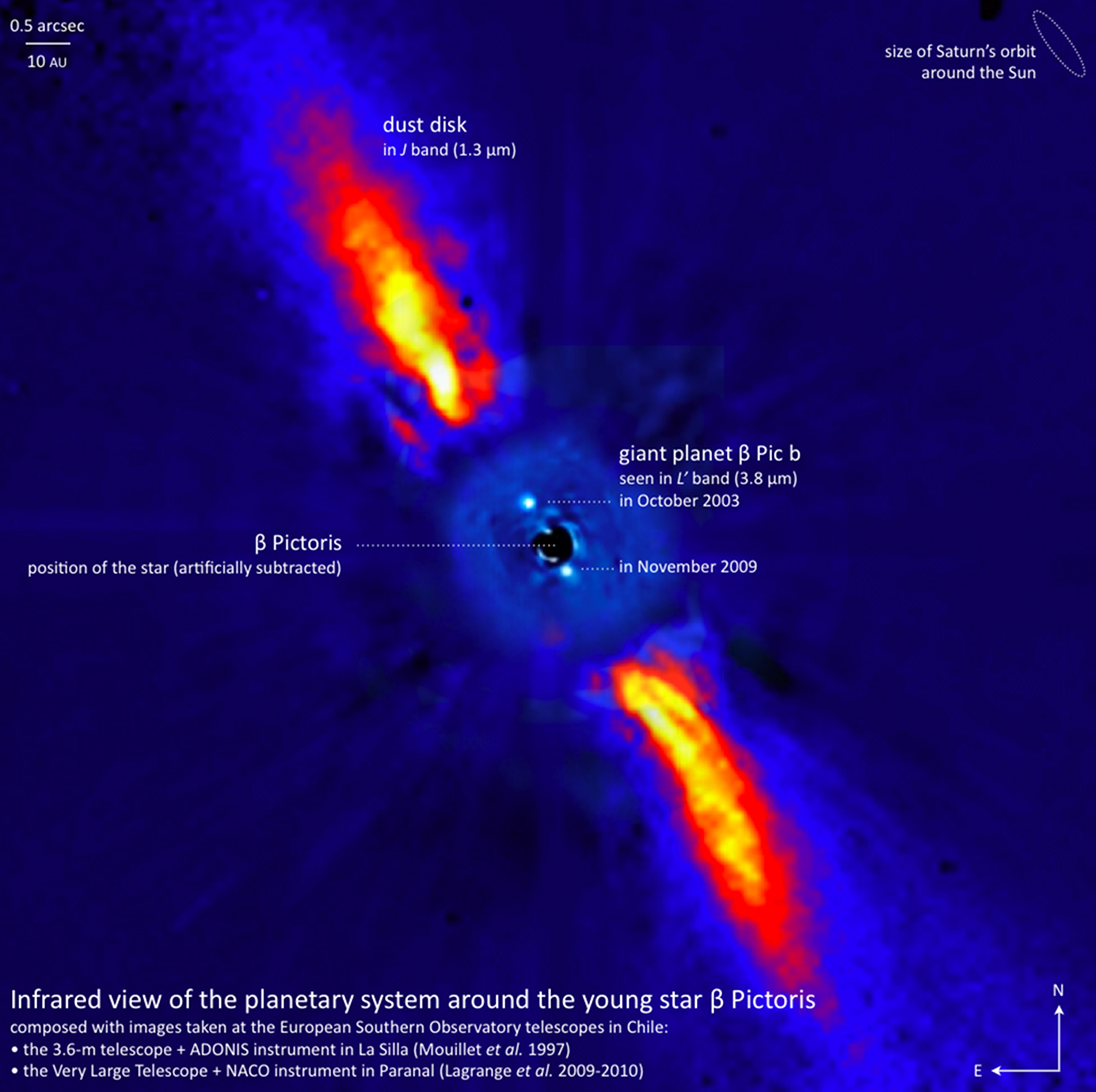 |
We know of about 300 stars with debris disks, indicating planet systems
actively evolving (and colliding) around them. The intense debris disk stage
appears to last about 100 million years, after which most planetary systems seem
to have "settled down" and have a lower rate of collisions and debris
generation. This time period matches pretty well the theoretical estimates for
the time required for our Solar System to have settled down. Like the three
examples above, perhaps all of these stars harbor planetary systems, but the
rest are too faint for us to image yet.
| Some of the other planet systems are very
nearby (on a cosmological distance scale). Here is a map of the summer sky
showing two of them. They (Tau Bootis and 70 Virginis to astronomers) are
about 50 light years away; Fomalhaut is at only 25 light years and other
candidates are as close as 10 light years. However, as in most known cases,
the planets are huge - similar to the mass of Jupiter - and orbit close to
their stars (the size of the Earth's orbit is shown in blue). (from Navigator Program Public
Engagement Team, NASA, http://planetquest.jpl.nasa.gov) |
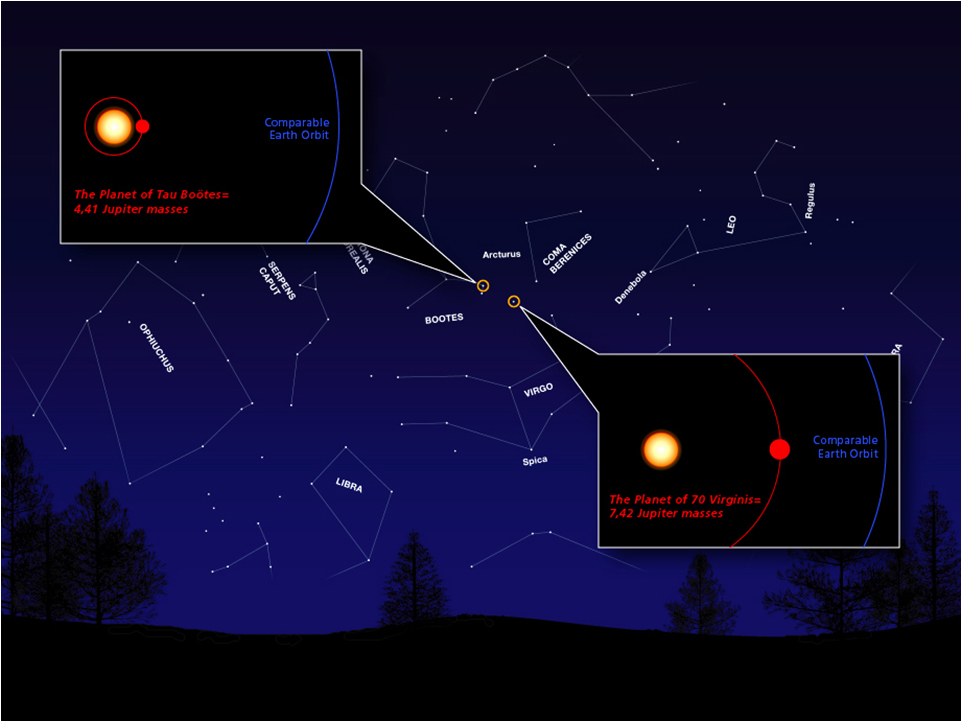 |
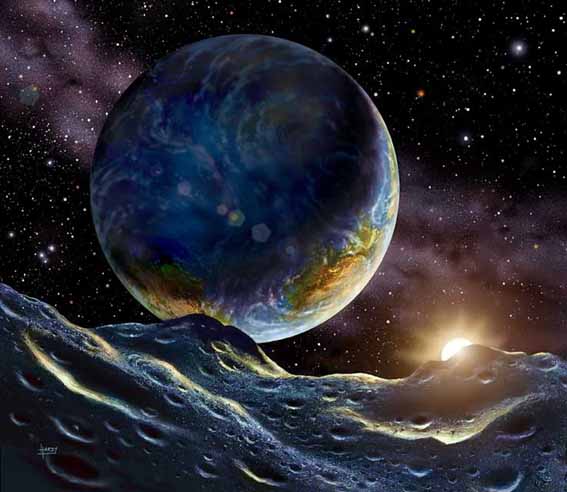 |
The big question is whether many Earth-like planets exist, since they
are potential sites for life and perhaps even civilizations Ambitious programs to
probe this question have fallen victim to budget woes in NASA, so we have to
wait for a definitive answer. Ambitious programs to
probe this question have fallen victim to budget woes in NASA, so we have to
wait for a definitive answer.
Here is an artist's idea of what it might look like to be
on a small moon orbiting an Earth-like planet. (by David Hardy, http://www.hardyart.demon.co.uk/html/main.html). |

Artist's concept drawing of JWST |

|
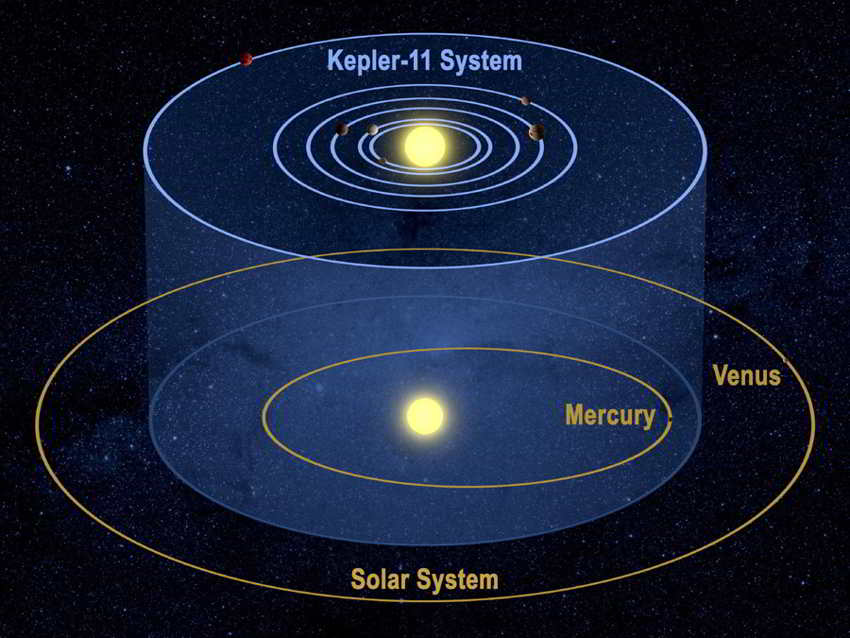
Two planetary systems from
http://wordlesstech.com/exoplanet-hunter-finds-multi-planet-solar-systems/ |
Click to return to syllabus |
Click to return to JWST |
hypertext  G. H. & M. J. SRieke G. H. & M. J. SRieke |
Click to go to Exoplanet System Comparison |




